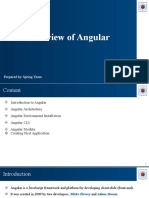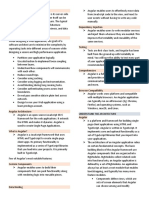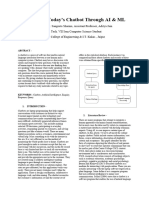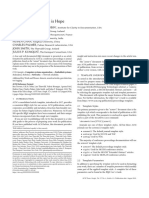Date : / / 2025
Development Using Angular and Spring Webserver Framework
Presented By : Milan Rane
Agenda
1.Introduction to Angular
2.Introduction to Spring
3.Key Features and Benefits
4.Development Process with Angular
5.Development Process with Spring
6.Conclusion
Introduction to Angular
Definition:
Angular is a comprehensive platform for building modern, singlepage
applications using HTML, CSS, and TypeScript. Developed and maintained by
Google,it provides a structured approach to developing interactive web
applications.
Purpose:
Facilitates Dynamic, SinglePage Web Applications (SPAs): Angular allows the
creation of SPAs, where the entire application loads once, and then the content is
dynamically updated based on user interactions. This approach leads to faster and
more responsive user experiences compared to traditional multipage applications.
Key Features of Angular
TwoWay Data Binding: Automatic synchronization of data between model and view
components.
Dependency Injection: Enhances code modularity and reusability by injecting
dependencies.
ComponentBased Architecture: Encourages building applications as a collection of
reusable components, improving modularity and maintainability.
TypeScript: Uses TypeScript, which adds strong typing and modern JavaScript
features.
Benefits of Angular
Improved Productivity: With a comprehensive CLI (Command Line Interface),
developers can quickly generate components, services, and other elements.
Enhanced Performance: AheadofTime (AOT) compilation improves application
performance by converting Angular HTML and TypeScript code into efficient
JavaScript code during the build process.
Large Community Support: A vast community and rich ecosystem of libraries, tools,
and resources for developers to leverage.
Introduction to Spring
Definition:
Spring is a popular tool that helps Java developers create all kinds of applications, from
simple websites to complex systems like microservices.
Purpose:
Simplifies Enterprise Java Development: Spring provides a set of tools and frameworks
that simplify the development of robust, scalable, and maintainable enterprise
applications. It offers features that simplify development and enhance performance. It
takes care of repetitive tasks (like managing connections or setting up configurations) and
allowing developers to focus on business logic.
Key Features of Spring
Dependency Injection: Manages object dependencies efficiently, promoting loose
coupling and easier testing.
AspectOriented Programming (AOP): Separates crosscutting concerns, such as
logging and transaction management, from business logic.
Spring Boot: Simplifies the creation of standalone, productiongrade Spring
applications with minimal configuration.
Security: Comprehensive security features to secure enterprise applications,
including authentication and authorization.
Benefits of Spring
Reduces Boilerplate Code: Spring simplifies repetitive code, allowing developers to
focus on business logic.
Easily Integrates with Other Technologies: Spring can be easily integrated with other
frameworks, libraries, and technologies, making it versatile for various projects.
Promotes Loose Coupling: By using dependency injection and modular architecture,
Spring applications are loosely coupled, enhancing maintainability and scalability.
Process Details
Hardware Specification :
OS Windows 7 or latest
RAM Minimum 8GB or more
HDD 128GB or More
Processor – Intel i5 or Higher
Software Specification :
JDK 11
VS Code 1.35.1 or latest(Editor).
Nodejs 10.0
AngularCLI 7.0
Eclipse IDE 201906 (version 4.12.0) or latest(Spring Boot Application
Developed in Eclispe)
Setting Up the Development Environment
Angular Setup:
Install Node.js and Angular CLI.
Create a new Angular project using `ng new`.
Spring Setup:
Use Spring Initialize to bootstrap a new Spring Boot project.
Dependency management with Maven or Gradle.
Building a Simple Angular Application
Creating Components:
Generate components using Angular CLI (`ng generate component`).
Routing:
Setting up routes for navigation between components.
Services:
Creating services for business logic and API calls.
Building a Simple Spring Application
Creating RESTful APIs:
Using `@RestController` for handling requests.
Implementing CRUD operations.
Database Integration:
Connecting to databases using Spring Data JPA.
Configuring application properties.
Connecting Angular with Spring
API Calls:
Using Angular’s HttpClient to communicate with Spring APIs .
Handling CORS:
Configuring CORS in Spring to allow requests from Angular.
Example: Show a simple API call from Angular to Spring and display results.
Best Practices
Angular Best Practices:
Structure your application with modules.
Use reactive programming with RxJS.
Spring Best Practices:
Keep controllers thin and delegate to services.
Use proper exception handling and logging.
Tools and Libraries
Development Tools:
IDEs: Visual Studio Code for Angular, IntelliJ IDEA for Spring.
Version Control: Git and GitHub.
Libraries:
Angular Material for UI components.
Spring Security for authentication and authorization.
Development Process with Angular
Setup Development Environment: Install Node.js, npm, and Angular CLI.
Create a New Project: Use Angular CLI commands to generate a new project.
Develop Components: Build reusable UI components for the application.
Services and Dependency Injection: Create and inject services to manage application data
and business logic.
Routing: Configure application routes to navigate between different views.
Build and Deploy: Compile the application and deploy it to a web server or cloud
platform.
Development Process with Spring
Setup Development Environment: Install Java Development Kit (JDK) and an IDE like IntelliJ IDEA or Eclipse.
Create a New Project: Use Spring Initializr to generate a Spring Boot project with desired dependencies.
Develop Components: Create REST controllers, services, and repositories for handling requests and business
logic.
Database Configuration: Configure and integrate with a database (e.g., MySQL, PostgreSQL) using Spring Data
JPA.
Security: Implement security features like authentication and authorization using Spring Security.
Build and Deploy: Package the application (e.g., as a JAR or WAR file) and deploy it on a server or cloud
platform.
Conclusion
Combining Angular and Spring: Using Angular for the frontend and Spring for the
backend creates a powerful stack for building robust, maintainable, and scalable
web applications.
FutureProof Applications: This combination ensures applications are built with
modern technologies and best practices, providing a solid foundation for future
enhancements and scalability.
Thank You






















































































